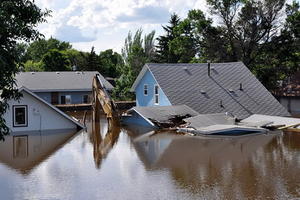Infrastructure protectionCosts of extreme weather events multiply
The United States sustained $1.15 trillion in economic loss in the past thirty years due to extreme weather, a trend that will continue if state and local governments do not prepare for future weather disasters, according to Munich Re, the world’s largest risk insurer.The GAO’s Mark Gaffigan told lawmakers that as a result of extreme weather, the federal government’s crop insurance program had increased four-fold since 2003, and the flood insurance program has a $24 billion debt.

Extreme weather events cost over 1 trillion doallars U.S. // Source: commons.wikimedia.org
The United States sustained $1.15 trillion in economic loss in the past thirty years due to extreme weather, a trend that will continue if state and local governments do not prepare for future weather disasters, according to Munich Re, the world’s largest risk insurer.
Department of Homeland Security’s (DHS) assistant secretary for policy David Heyman recently testified before the Senate Committee on Homeland Security and Governmental Affairsabout the cost of extreme weather events. In 2011, fourteen different natural disasters exceeded $1 billion each in damage caused, and there were ninety-eight presidentially declared disasters. “Without a concerted effort — national resilience effort, the trend is likely to continue,” Heyman warned.
CBS News reports that Heyman and Caitlin Durkovich, DHS assistant secretary for infrastructure protection, national protection and programs directorate, highlighted for the committee the importance of implementing a national preparedness system as a way to be better prepared for disasters. Heyman and Durkovich are creating Resilience STAR, a program similar to the Energy STAR program, which will designate structures which are built to withstand damage from certain disasters. “Our investments in resilience will pay significant dividends for the country. It is efficient and it is cost-effective,” Heyman said.
The ability for communities to respond swiftly to natural disasters is a matter of national security. “Just as terrorist attacks threaten our communities, extreme weather disrupts the security of our nation. Extreme weather strains our resources, diverts attention from counterterrorism efforts, serves as a threat-multiplier that aggravates stressors both at home and abroad, and destabilizes the lifeline sectors on which we rely,” Durkovich said.
Mark Gaffigan, the managing director of the U.S. Government Accountability Office’s (GAO) National Resources Environmental team, told the Senate committee that the federal government’s crop insurance program had increased four-fold since 2003, and the flood insurance program has a $24 billion debt. Gaffigan said that in addition to finding ways to reduce disaster risks, the federal government should begin fully budgeting for the response to weather disasters, which often comes from outside the normal budgeting process.
Senator Thomas Carper (D-Delaware), the committee’s chairman, says that the hearing was not focused on debating climate science, but “instead, it’s about trying to find common ground. And as our country debates how to address our changing climate and the extreme weather I believe it’s likely causing, our witnesses will deliver to us a clear message,” he said. “And that is, put simply, the increase in frequency and intensity of those extreme weather events are costing our country a boatload of money.”
